History
Bissara Tower is a civic tower that overlooks Piazza dei Signori, alongside the famous Basilica Palladiana. At 82 meters high, it is one of the tallest buildings in Vicenza.
The earliest records date back to 1174 when the tower was built at the behest of the family Bissari, next to their palazzo. Between 1211 and 1229 the municipality of Vicenza bought both the building (with the intention of turning it into the mayor's office) and the tower. The tower was not damaged in the terrible earthquake of January 25, 1347. In the mid- fifteenth century the tower was raised to the present height. The relics of saints and five bells were placed inside. Over the centuries, many interventions were done to maintain the stability and beauty of the tower.
The history of the city is described in its stones: on top there is a headless statue of the goddess Athena from the Roman era; almost at the top there is the marble bas-relief of the Lion of Saint Mark, symbol of the Serenissima; at the base is a triumphal arch with the war memoria.
On 18 March 1945, the tower (along with the Palladian Basilica) was hit in an Anglo-American bombing raid. The top of the tower caught fire and the dome collapsed to the ground: the tower was severed. The bells also had fallen off, destroying the pavement of the square. Together with the Basilica, in the years after the tower was rebuilt, not without controversy concerning the form, in part different from the original. Not all of the bells were also relocated, nor the ball indicating the moon's phases (which was placed under the clock).
In 2002 a radical restoration of the tower was approved. The interventions addressed two issues: first the subsidence of the foundations (an ever-present problem in Vicenza given the abundance of water in the subsoil), the secondly, the restoration of the external surfaces, ornaments and decorations. The dial has been painted cobalt blue (as it was originally), the sphere of the moon's phases (thanks to a donation from a well-known jeweller) has been repositioned and the bells replaced (donation by the Rotary Club Vicenza Berici).
A feature of the tower is, in addition to the normal sound of the hours and half-hours, also the ninth hour. This is a particular melody composed by Maestro Valtinoni (restored in 2005) is played seven minutes before noon and seven minutes before six p.m. The largest bell, in a tone of E, was created in 1663 by the foundry of Christopher Murari.

Padua is a city and commune in Veneto, northern Italy. Padua is on the river Bacchiglione, west of Venice. It is the capital of the province of Padua. It is also the economic and communications hub of the area. Padua's population is 214,000. The city is sometimes included, with Venice and Treviso, in the Padua-Treviso-Venice Metropolitan Area (PATREVE) which has a population of around 2,600,000.

Vicenza is a city in northeastern Italy. It is in the Veneto region, at the northern base of the Monte Berico, where it straddles the River Bacchiglione. Vicenza is approximately 60 kilometres (37 mi) west of Venice and 200 kilometres (120 mi) east of Milan.

Andrea Palladio was an Italian Renaissance architect active in the Venetian Republic. Palladio, influenced by Roman and Greek architecture, primarily Vitruvius, is widely considered to be one of the most influential individuals in the history of architecture. While he designed churches and palaces, he was best known for country houses and villas. His teachings, summarized in the architectural treatise, The Four Books of Architecture, gained him wide recognition.

The Basilica Palladiana is a Renaissance building in the central Piazza dei Signori in Vicenza, north-eastern Italy. The most notable feature of the edifice is the loggia, which shows one of the first examples of what have come to be known as the Palladian window, designed by a young Andrea Palladio, whose work in architecture was to have a significant effect on the field during the Renaissance and later periods.

The Basilica di Santa Maria Gloriosa dei Frari, commonly abbreviated to the Frari, is a church located in the Campo dei Frari at the heart of the San Polo district of Venice, Italy. It is the largest church in the city and it has the status of a minor basilica. The church is dedicated to the Assumption of Mary.
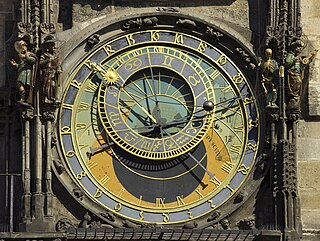
An astronomical clock, horologium, or orloj is a clock with special mechanisms and dials to display astronomical information, such as the relative positions of the Sun, Moon, zodiacal constellations, and sometimes major planets.
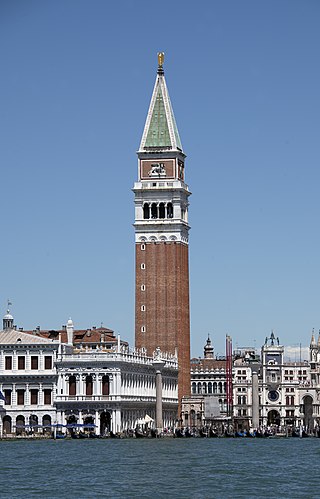
St Mark's Campanile is the bell tower of St Mark's Basilica in Venice, Italy. The current campanile is a reconstruction completed in 1912, the previous tower having collapsed in 1902. At 98.6 metres (323 ft) in height, it is the tallest structure in Venice and is colloquially termed "el paròn de casa". It is one of the most recognizable symbols of the city.

The Palazzo della Ragione is a medieval market hall, town hall and palace of justice building in Padua, in the Veneto region of Italy. The upper floor was dedicated to the town and justice administration; while the ground floor still hosts the historical covered market of the city. The palace separates the two market squares of Piazza delle Erbe from Piazza dei Frutti. It is popularly called "il Salone" . It is part of the UNESCO World Heritage Site of Padua's 14th-century fresco cycles.

St Mark's Clock is housed in the Clock Tower on the Piazza San Marco in Venice, Italy, adjoining the Procuratie Vecchie. The first clock housed in the tower was built and installed by Gian Paolo and Gian Carlo Rainieri, father and son, between 1496 and 1499, and was one of a number of large public astronomical clocks erected throughout Europe during the 14th and 15th centuries. The clock has had an eventful horological history, and been the subject of many restorations, some controversial.

Padua Cathedral, or Basilica Cathedral of Saint Mary of the Assumption, is a Catholic church and minor basilica located on the east end of Piazza Duomo, adjacent to the bishop's palace in Padua, Veneto, Italy.

The palazzo del Capitaniato, also known as loggia del Capitanio or loggia Bernarda, is a palazzo in Vicenza, northern Italy, designed by Andrea Palladio in 1565 and built in 1571 and '72. It is located on the central Piazza dei Signori, facing the Basilica Palladiana.
Palazzo della Ragione may refer to:

Piazza dei Signori is a city square in Padua, region of Veneto, Italy. This piazza for centuries hosted official civic and government celebrations, while the larger squares of Piazza delle Erbe (herbs) and Piazza della Frutta (fruits) hosted commerce and public festive celebrations. The square is dominated by the famous Clock Tower.
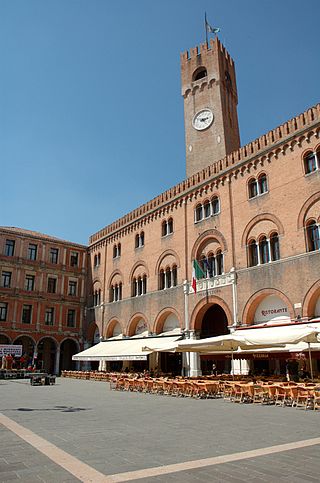
Piazza dei Signori is a city square in Treviso, north-eastern Italy.

Piazza dei Signori is a city square in Vicenza, Italy.

The church dedicated to saint Francis of Assisi, known for centuries as San Francesco Grande is a religious building on the Via San Francesco, previously overlooks the Contra porteghi high in Padua, Italy. Through the efforts of Baldo de Bonafarii and Sibilla de Cetto, the convent of the Friars Minor and the Hospital of Saint Francis, Major, operated until 1798.
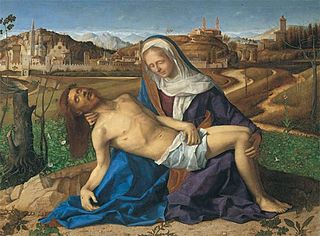
The Martinengo Pietà is an oil painting on panel of c. 1505 by the Italian Renaissance master Giovanni Bellini, signed on the rock to the left of the Virgin. It was previously in the collections of the Martinengo family and of Donà delle Rose and is now in the Gallerie dell'Accademia in Venice.

The Jewel of Vicenza was a silver model of the city of Vicenza made as an ex-voto in the 16th century and attributed to the architect Andrea Palladio. The Jewel was stolen by the Napoleonic army during the Italian Campaign in the French Revolutionary Wars and subsequently destroyed. A copy was created between 2012 and 2013.
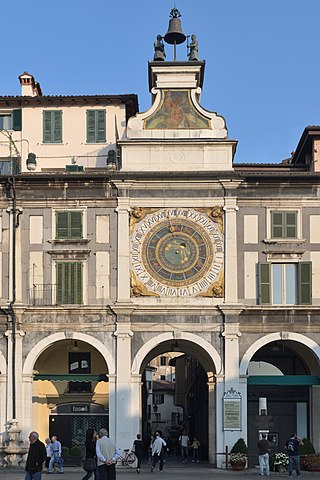
The Torre dell'Orologio is a 16th-century building located in the Piazza della Loggia in Brescia, northern Italy.

The Torre dell'Orologio is a 15th-century renaissance tower on the Piazza delle Erbe in Mantua, Italy. It is attached to the Palazzo della Ragione, and next to the Rotonda di San Lorenzo. It houses an astronomical clock.
























